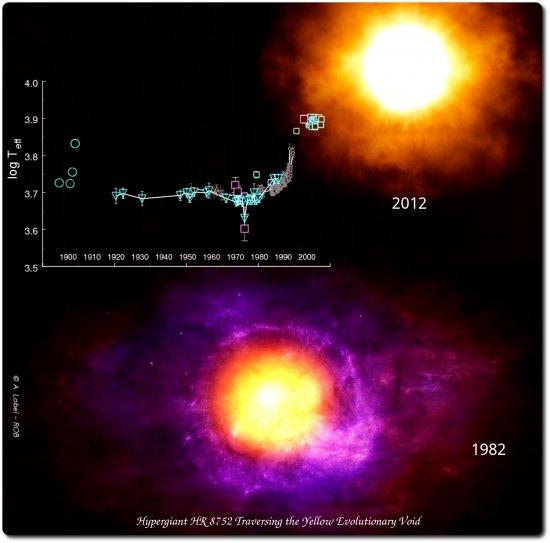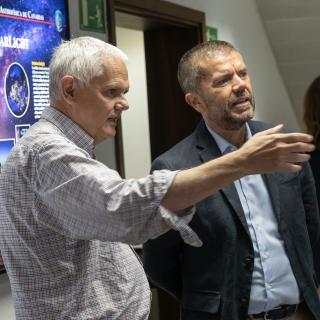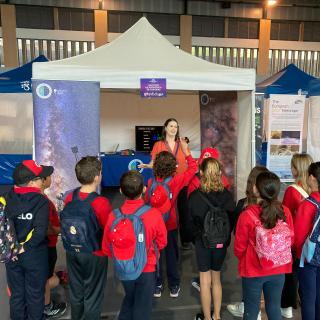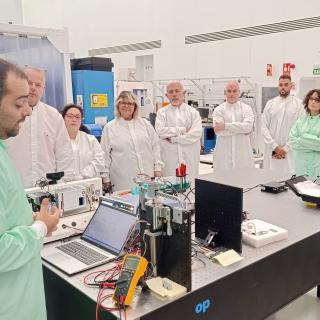The team has discovered that HR 8752 has increased its surface temperature by a spectacular 3000 K as it has passed through an evolutionary stage known as the Yellow Evolutionary Void.
This finding is key to our understanding of the evolution of these kinds of stars, which can achieve a brilliance millions of times greater than that of the Sun.
A team of scientists from six European countries, with the participation of the Instituto de Astrofísica de Canarias (IAC), has just brought to a close thirty years of research into the hypergiant star HR 8752, bearing witness to its passage through the so-called Yellow Evolutionary Void, an unstable stage that can profoundly alter the evolution of a star. In fact, the surface temperatura of the star has risen rapidly from 5000 to 8000 kelvin during the period analysed. This result, published in the journal Astronomy and Astrophysics, marks the discovery of a fundamental missing link in the evolution of hypergiant stars.
Hypergiants are the most luminous stars known at present in the Universe. They can attain a brilliance millions of times greater than that of the Sun and reach a size of several hundred solar radii, with surface temperatures ranging from 3500 K to 35,000 K. HR 8752 is 250,000 times more luminous than our Sun and can be observed with binoculars in the northern constellation of Cassiopeia. Hypergiants are rare objects, only 12 of them being known in our Galaxy.
The Yellow Evolutionary Void (YEV) is a an evolutionary stage in which the temperature and luminosity of a star can dramatically change its history. The team of astronomers has discovered that the atmospheres of hypergiants are unstable in this zone because the direct outward forces on their atmospheres equal or even exceed the inward graviational pull.
When they enter this ‘forbidden zone’ in the evolution of their stellar parameters, these giant stars lose tremendous amounts of mass (as much as a solar mass in less than a year) owing to the instability of their atmospheres. For this reason, once the star is in this zone, it has to leave it as quickly as possible. That is why there are many stars to either side of it but very few within it.
The hypergiant HR 8752 was ‘capturedt’ in its passage through this zone, allowing reseearchers to make a detailed study of the physics of the región, thus ascertaining what has happened to the star, how it lost its mass, how quickly its atmosphere has changed, et cetera.
Garik Israelian, coauthor of the study and IAC ressearcher, explains: ‘Way back in 1999 in a study we published in The Astrophysical Journal Letters we realized that this hypergiant had increased its temperature by 3000 K in less than 30 years. A similar phenomenon was discovered in another hypergiant called Rho Cassiopeiae, when a spectacular eruption took place in the year 2000. ‘
‘These stars,’ adds Israelian, ‘attract a great deal of attention because we expect them to explode as supernovae in less than 1000 years. Given the distances a which they are located, it’s posible that some of them will cease to exist forever.’
During the last decade, Israelian has made many spectroscopic observations of this star with the WHT and NOT telescopes at Roque de los Muchachos Observatory in La Palma, and further observations with the STELLA robotic telescope at Teide Observatory, although these data are still in the process of analysis and have not yet been published. ‘Stars like HR 8752 are full of interesting physical enigmas still to be revealed. They are excellent obects for networks of robotic telescopes all over the world,’ Israelian stresses.
Three decades of research
While the analysis of previous photometric observations shows that, at least between 1900 and 1980, HR 8752 maintained an almost constant surface temperature of 5000 degrees, towards 1985 the team observed certain indications that this star was fairly close to, or even beyond the lower temperature limit of the Void. With the open question of what had happened, the scientists decided to embark on a long and systematic programme of spectroscopic observations that would last for three decades until the present.
These spectroscopic observations have now revealed that, in the twenty-year period between 1985 and 2005, the surface temperature of the star had risen rapidly from 5000 to 8000 degrees as it passed through a series of events that brought about large losses of its mass. During this time, the radius of the star had decreased from 750 times that of the Sun as measured in 1985 to a mere 400 times the solar radius in 2005.
Hans Nieuwenhuijzen, former researcher at SRON, points out: ‘Our team made a tremendous combined effort to observed HR 8752 and now we are delighted to see these marvellous results after so many years. We knew that this was the hypergiant to observe and we have been rewarded.’
‘On the shoulders of hypergiants’
The observations show that the observed hypergiant partly crosses the YEV. ‘Indeed, this finidng is a definite confirmation of theoretical research into the YEV,’ says Kees de Jager, a member of the team and former director of SRON, a scientist noted for his work on hypergiants.
With these conclusions, the research team have taken research on hypergiants a step forward: other stars of this type can reveal similar spectacular features. The team has therefore chosen a number of candidates to monitor spectroscopically in search of these enormous temperatura changes on the scale of a human lifetime.
The team of astrophysicists comprises: H. Nieuwenhuijzen (SRON Laboratory for Space Research, Netherlands), C. de Jager (NIOZ Royal Netherlands Institute for Sea Research, Netherlands), I. Kolka (Tartu Observatory, Estonia), G. Israelian (Instituto de Astrofisica de Canarias, España), A. Lobel (Royal Observatory of Belgium), E. Zsoldos (Konkoly Observatory, Hungary), A. Maeder (Observatoire de Genève, Switzerland) and G. Meynet (Observatoire de Genève, Switzerland).
For further information contact:
Garik Israelian (IAC). gil [at] iac.es (gil[at]iac[dot]es). +34 922 605258, +34 922 605200.
Reference and article abstract: http://adsabs.harvard.edu/abs/2012A%26A...546A.105N
Related IAC press reléase:: http://www.iac.es/divulgacion.php?id=331&op1=16



